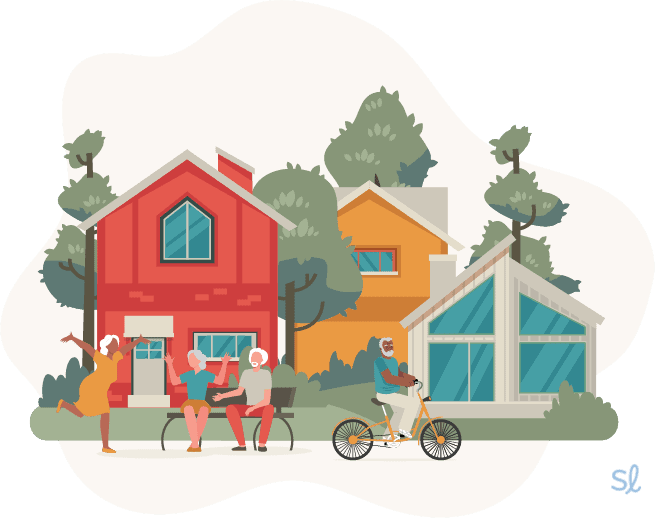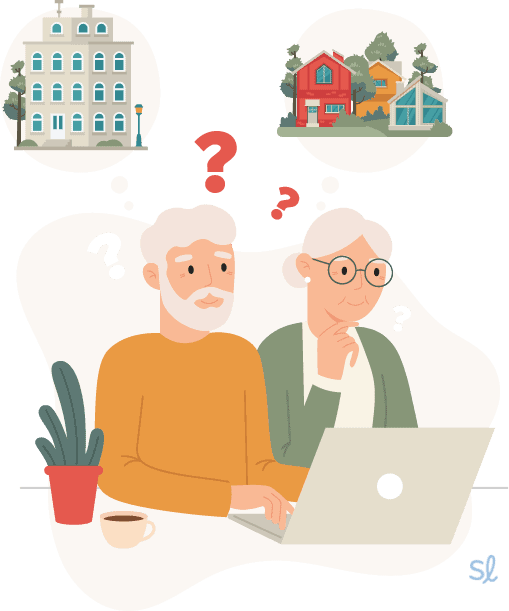Senior Apartments in 2025
Senior apartments offer an affordable place to find community and live a low-maintenance lifestyle.
SeniorLiving.org is supported by commissions from providers listed on our site. Read our Editorial Guidelines
Find Senior Apartments Near You
Join 1,019,247 Seniors Who've Searched for Housing Communities on SeniorLiving.org.
Find Senior Apartments Near You
Senior Apartments: Key Takeaways
- Senior apartments offer a sense of community for residents in similar phases of life.
- Apartments for seniors may have age-friendly amenities and floor plans designed for older adults’ needs and lifestyles.
- Some senior apartments are in assisted living communities. Our guide to assisted living covers everything you need to know about this type of senior living that offers a little more hands-on care.
Senior apartments are enticing options, as the living cost is lower, the benefits are ample, and the maintenance is minimal. Did we mention that apartment communities include others making the most of their golden years? Plus, it has all the perks of independent living without all the hassle.
Read on to learn more about the types of senior apartments, their costs, and how to pay for them (whether you rent or buy). Many seniors have limited income, so we’ll dive into affordable housing for seniors and how to apply for federal and state assistance. Have a tour coming up? We have the questions you should ask when considering an apartment. We’ll also discuss what organizations and groups can help you find your ideal senior living apartment.
Stay Safe: USA.gov cautions buyers and renters to learn about housing scams. Want to find out how to avoid becoming the next scam victim? Our team has compiled a guide to common scams targeting seniors so you can stay protected
Table of Contents
What Is a Senior Apartment?
Packed with age-friendly accommodations and amenities, a senior apartment caters to the lifestyles of older adults. As we age, our needs change, so these age-restricted apartments (typically 55+ or 62+ or older) have us covered. Senior apartments are built with the needs of older adults in mind. For example, the quarters may offer ground-level accommodations such as an elevator, wheelchair-accessible units, and safety features.
Senior apartments vary in size and setup with many different types of 55+ communities ranging from golf and resort communities to singles communities. Studio apartments offer a compact yet open floor plan. There’s only one room (other than the bathroom), but it contains everything you need for a complete living experience.
Other lodgings are suite-style, meaning each older adult has a bedroom while sharing a common living space, kitchen, and bathroom with other residents. Or, if you need more space to stretch out, choose a multi-room one- or two-bedroom apartment. Compared to studio or suite apartments (which are more communal), multi-room senior apartments can help older adults transitioning to apartment living feel like they are in their own homes.
Gone are the days of costly home repairs, landscape maintenance, and meal-prepping. Senior apartments allow residents more time to do the things they love. Many communities include common areas to chat over coffee, relax during movie night, and enjoy a meal in the dining lounge. They also provide social activities and ways to pick up a new hobby. They may even have more luxury amenities like a pool or clubhouse, giving you more ways to connect with your neighbors.
In a way, it’s not unfair to liken senior apartments to college dorms. Both offer the freedom and privacy of living alone, with benefits and social opportunities for residents. They also cater to specific age groups. Of course, senior apartments don’t require you to enroll in any classes – no need to worry about homework again!
Our free housing and care finder uses your unique needs to curate a list of the best options in your area.
Who Lives in Senior Apartments?
Senior apartments have a wide range of residents! Here’s a snapshot of adults who call a senior apartment “home sweet home,” including those who:
- Have sold their home and downsized to simplify their lifestyle.
- Want the freedom to travel without the worry about property left behind.
- Want a place with minimal responsibilities and upkeep.
- Are divorced, widowed, or never married.
- Have relocated to be closer to family and friends.
- Want a lower-cost living solution.
- Want to be around their peers.
- Are looking for a sense of community and safety.
Can Children or Spouses Live in a Senior Apartment?
Senior apartments often have age requirements, but these requirements vary by community. That means children or younger adults might not be allowed to live with you, depending on the chosen apartment. During your search, ask if the property is a 55+ or 62+ community. The rules may differ depending on your state. It is critical to ask, especially if you’re moving across state lines.
Spouses
According to the U.S. Department of Housing and Urban Development’s (HUD) Fair Housing Act, to be deemed as 55+ senior housing, 80 percent of the units must have at least one occupant who is 55 years of age or older.2 As long as one household member meets the minimum age in a 55 and over community, spouses should be eligible. However, most 62+ senior apartments have a strict age policy and offer no exceptions to the rule. All residents must be 62 and above.
Children
55+ senior living communities tend to be more flexible regarding the residents’ children. One scenario would be when a senior resident is the legal caretaker for their disabled adult child. Most 62+ properties offer no exceptions, so children are forbidden to live in these units with older adults.
While children and grandchildren cannot live in senior apartments, they can certainly visit! Apartment rules and regulations vary, so before that weeklong sleepover, confirm what counts as short-term visits. Some senior apartment complexes even include small playgrounds or host monthly kid-oriented events for the grandkids.
Senior Apartment Qualifications
Most senior-focused communities come with certain age restrictions. To qualify, you must provide proof of age, such as a birth certificate, driver’s license, or passport. Under HUD’s Housing for Older Persons guidelines, at least one occupant must be 55 or older. If your spouse or partner is under 55, confirm with the senior apartment if there is an age minimum (for example, age 40). Age minimums are set at the discretion of the apartment management. Other qualifications may be necessary for affordable housing or similar apartments.
Types of Senior Apartments
There are generally three pricing categories of senior living apartments — affordable, market rate, and luxury. However, you may not find all three in every market.
Quick Tip: Want to learn more about senior housing options? Visit our guide to planning for housing in retirement and our guide to retirement communities for a closer look.
Affordable Senior Living Apartments
Income-restricted older adults may qualify for affordable senior living apartments through federal, state, and local housing programs. Rent goes below the market rate, with eligibility based on income, family size, the area’s median income (AMI), and other factors. Amenities in low-income senior apartments tend to be limited. If you’re looking to retire soon, check out our guide to the best places to retire, which includes a list of the cheapest cities and states to call home sweet home.
Market Rate Senior Living Apartments
Unlike affordable living apartments, market-rate senior apartments don’t have income limits. They often include amenities like housekeeping, transportation, and community dining. Market-rate apartments are competitively priced based on comparable housing in the area. However, carefully choose where you decide to live, as the Harvard Joint Center for Housing Studies (JCHS) reports that rent in professionally managed apartment buildings has skyrocketed in the past few years.3
Luxury Senior Living Apartments
At the top of the price line, you’ll find resort-style luxury apartments for seniors. They’re larger, often up to 2,000 square feet, and provide plenty of upscale amenities and community activities for their residents. It’s common for luxury apartments to be gated communities, offering privacy, security, and a feeling of exclusivity. Be prepared to pay a steep price tag. The entrance fee alone can reach six digits. Check out our luxury retirement and senior living guide to learn more.
Senior Apartment Amenities
Amenities will vary from complex to complex, but in general, you’ll find the following:
- One- and two-bedroom options
- Private or shared apartments
- Large walk-in showers with safety features
- Common areas with a TV, game room, or library
- Laundry rooms with washers and dryers
- Transportation to shopping and medical appointments
Premium amenities may include:
- Expanded common areas with pool tables, darts, or other activities
- Fitness center
- Beauty salon and spa
- Indoor and outdoor swimming pools
- 24-hour concierge service
- On-site pharmacy with delivery
- Housekeeping, including linen and laundry service
- Dog walking and grooming (may also apply to other pets)
- Recreational, cultural, and educational activities and programs
Senior Apartment Care Options
Senior apartments cater to healthy older adults living independently. If you or your loved one needs help with the basic activities of daily living (ADLs) categorized as personal hygiene, grooming, dressing, toileting, ambulating (getting out of bed or a chair and walking), or eating, an assisted living senior apartment offers more hands-on care.
Significant differences exist between living independently in a senior citizen apartment and assisted living. To help you in your housing journey, our experts have compiled a summary of assisted living vs. independent living features, pricing, and how to choose the best option for your needs.
Did You Know? Many older adults may find comfort in knowing that help is nearby. Check out our guide to finding the best medical alert system to keep your loved ones safe.

SeniorLiving.org is supported by commissions from providers listed on our site. Read our Editorial Guidelines
How Much Does a Senior Apartment Cost?
Just like any other type of housing, senior apartment costs vary greatly. Before you begin apartment hunting, ensure your finances are in order and set a budget. Average senior apartment rental prices across the U.S. vary greatly. For example, Brookdale Senior Living, the biggest assisted living provider in the United States, reports its prices range from $1,650 per month in the Southeast region to $16,165 per month in the Northeast.
Major factors that impact the overall cost include location, amenities, and apartment size. For example, a senior living one-bedroom apartment in rural Ohio will cost significantly less than a comparable senior apartment in New York City. If you’re on a budget, consider following these helpful frugal living tips for seniors.
Buying a Senior Apartment
It’s common to find senior apartments for sale in continuing care retirement communities (CCRCs). Buying into these communities is a long-term investment that enables older adults to transition to different housing and care levels. For example, an individual may initially move into a senior apartment but need assisted living, memory care, or hospice care in the future. CCRCs provide a multifaceted network of senior living options in one community. All your current (and future) health and wellness needs are covered! Before investing in a senior apartment, consider factors like tax implications and resale restrictions.
Renting a Senior Apartment
Most apartment rentals go through an apartment management company or assisted living community. Take time to weigh the pros and cons of renting a senior apartment. A significant benefit is that renting is a short-term commitment. You are free to move if your needs change, and you don’t have to worry about budgeting for property taxes. Plus, renter’s insurance is considerably less than homeowner’s insurance. On the flip side, you don’t own the property. Therefore, you won’t earn any profit. Altering the apartment, such as painting the walls, may be forbidden. Another point worth remembering is that income-based senior apartments include strict government guidelines; not all older adults qualify for income-based housing.
Did You Know? You can find assisted living apartments in cities across the country. Whether you’re looking for assisted living in New York City or San Diego assisted living communities, there are plenty of apartment options!
Low-Income Apartments for Seniors
There are more than 17 million economically insecure older adults with incomes below 200 percent of the federal poverty level.5 With rising inflation and the dramatic increases in living costs, many areas of our country are in an affordable housing crisis. That’s where low-income apartments for older adults come into play.
There are several types of limited-income housing for seniors, including those offered through the U.S. Department of Housing and Urban Development (HUD), Veterans Affairs, local and state subsidies, and nonprofit organizations. Below are several options to explore:
- Housing Choice Voucher: This federal government program (AKA Section 8 housing) is for extremely low-income families, seniors, and disabled individuals. Participants can find their housing and pay for some (or all) of the rent via their voucher.
- Public Housing Program: Local public housing agencies (PHAs) manage public housing properties in apartments set aside for low-income seniors.
- State Rental Assistance: Aside from federal rental assistance, programs sponsored by your state or local government or other organizations could help you.
- Veterans Administration Housing Help: The VA provides housing assistance for low-income veterans, including retirement homes, assisted living, and in-home care.
- Supportive Housing for the Elderly Program: HUD’s Section 202 housing assistance provides extremely low-income individuals ages 62 and over the opportunity to live independently but with vital support services such as nutrition, transportation, continuing education, and health-related services.
- Privately Owned Apartments: These low-income apartments offer reduced rental rates for seniors. They may feel more homely than regular apartments. Contact your local or county office for additional information.
Federal and state agencies determine the income guidelines for low-income apartments. To find out if you qualify and for a list of senior apartment locations, contact your local public housing agency or HUD office. HUD also offers an information page counseling older adults on frequently-faced housing concerns.6 Finding affordable housing can feel like an uphill battle. We’ve put together a guide on how to afford senior housing and elder care to help you through the process.
Once you find a senior apartment, it’s time to apply. Remember, most apartments are occupied, with applicants on a waiting list. However, certain exceptions will help your case, such as being homeless or living in an unsafe environment. Submitting your application to multiple HUD-sponsored apartments may increase the chances of being selected.
Questions to Ask When Selecting a Senior Apartment
Once you’ve found a few senior apartment communities you’d like to explore, you’re ready to take the next step. Contact the senior apartment manager to set up a tour. Tours are a fantastic way to see if the apartment feels like “home.” If possible, spend some time in the common area or dining hall and ask the apartment manager what other amenities the facility offers. It gives you a great view of the residents and staff. As you explore each senior apartment community, consider the questions below during your visit.
Health and Safety Questions
- Are grab bars installed in the bathtub, shower, and next to the toilet?
- Are easy-access walk-in tubs an apartment option?
- Is the senior apartment a gated community with security cameras?
- Are there security guards or someone on duty to monitor the facility?
- Are there smoke detectors, fire alarms, and a sprinkler system? How regularly are they checked?
- What is the proximity to the local hospital, medical, and dental care?
- Is the flooring non-slip for fall prevention?
- Is there an elevator and areas for wheelchair accessibility?
- How safe is the surrounding neighborhood?
- Who is allowed to enter regularly? Are there guest passes?
Apartment Living Questions
- Is there a maintenance person and property manager on-site?
- Are there any additional deposits or added fees?
- Are the staff and residents friendly?
- Can the interior be painted the color of your choice? Additionally, can items like art and shelving units be hung up?
- Is internet service included?
- Is the parking area convenient and well-lit at night? Are there garages for residents to use?
- Are there in-unit washers and dryers? Are they free to use? Or is there a communal laundry room with a fee?
- Are on-site storage units available?
- Are the apartments pet-friendly?
- Is transportation to doctors and shopping provided?
- Is the apartment rent-controlled?
- Does the senior apartment complex accept HUD subsidies or rent vouchers?
- Are the grounds well kept?
- Is your spouse able to live with you? Are younger family members able to visit?
Community Questions
- Are there typical conveniences like shopping, churches, and restaurants in the area?
- Are there walking trails and parks nearby?
- Are there common areas for residents to use?
- Is the apartment complex a non-smoking community?
- Are group activities and outings offered?
- Is there a clubhouse, pool, or fitness center?
- Do they offer worship services or a chapel?
- Is there a minimum age limit for applying to a senior-specific community?
How Do I Find a Senior Apartment Near Me?
Apartments can be ideal for older adults looking for an inexpensive, low-maintenance lifestyle! To find senior living apartments in your area, search our state and local directory or call our senior living helpline. Another excellent resource is your local senior community center. Senior centers are one of the most widely used services among America’s older adults. More than 1 million older adults are served by a senior center each day, according to the National Council on Aging (NCOA).4
According to the NCOA,
“research shows older adults who participate in senior center programs can learn to manage and delay the onset of chronic disease and experience measurable improvements in their physical, social, spiritual, emotional, mental, and economic well-being.”
Finding the best senior apartment takes a bit of detective work. If you’re searching for senior apartments without income guidelines, check with privately owned apartments and senior living facilities. It’s helpful to create a list of independent living centers, active senior housing, assisted living facilities, and CCRCs near you (or where you’d like to live). You should also consider any amenities you want access to. That way, you can check off the housing managers you’ve spoken to and whether or not the community includes senior apartments.
Sometimes, searching for the best senior apartment is a team effort, so don’t be shy! Ask family and friends for help with research and apartment tours. Having outside opinions on the features and benefits you need may be fruitful.
Paying for Senior Apartments
Once you choose an apartment that meets your needs and lifestyle, it's time to finance your housing solution. For older adults who have retirement savings set aside, this is an optimal way to pay for senior apartments. For low-income seniors, HUD-sponsored apartments offer more affordable monthly rent based on income. No one wants to be financially overextended in their golden years, so let’s look at the different ways to pay for a senior apartment.
If you can pay out-of-pocket for a senior apartment, tally up your financial resources and outstanding debt. Many seniors sell an existing home or take out a reverse mortgage to finance senior living. If this is an option, it will likely cover most of the living expenses. Other solutions to help cover housing expenses include using Social Security benefits, dividends from investment income, and cashing in a whole life insurance policy.
If you qualify as a low-income senior, it’s crucial to complete and submit your application for HUD-sponsored apartments or the Housing Choice Voucher program as soon as possible. As mentioned, low-income housing often has waitlists, which may be closed if the Public Housing Agency has more individuals signed up than can be helped shortly.
What Organizations Help Older Adults Find Senior Apartments?
Eldercare Locator is a service of the Administration on Aging (AOA) that connects older Americans and their caregivers with trustworthy local support resources.7 The Eldercare Locator can help you understand housing choices and make informed decisions. To learn about housing options available in your community, contact your local Agency on Aging by entering your ZIP code on the Eldercare Locator housing page or by speaking with an information specialist at 1-800-677-1116.
Volunteers of America (VOA) is the nation's largest nonprofit provider of quality, affordable senior housing for low- and moderate-income levels.8 The VOA’s affordable housing network includes over 500 properties in 42 states and Puerto Rico. This organization helps you find housing based on income guidelines, veteran status, or one’s disability. Volunteers of America is also a substantial provider of professional long-term nursing care for older adults.
HumanGood is a nonprofit senior living provider. They operate over 100 affordable housing communities in five states (California, Delaware, Oregon, Pennsylvania, and Washington). HumanGood also guides continuing care retirement communities with assisted living, memory support, and skilled nursing.
Mercy Housing offers affordable, program-enriched housing across the country. This nonprofit organization manages hundreds of properties and has helped provide over 100,000 affordable homes.
Senior Living Housing Guide
Finding the perfect senior living facility can be difficult. The video below features Jeff Hoyt, SeniorLiving.org’s editor-in-chief, covering various senior housing types.

Feeling uncertain if living in a senior apartment is the right choice? No need to fret; you have plenty of options!
U.S. Census Bureau. (2022, Feb). Demographic Turning Points for the United States: Population Projections for 2020 to 2060.
U.S. Department of Housing and Urban Development. (2023). THE FAIR HOUSING ACT: HOUSING FOR OLDER PERSONS.
JCHS. (2022). New Report Shows a Surging Rental Market, Starkly Divided by Race and Renter Incomes.
Brookdale. (2024). How Much Does Independent Living Cost?
United States Census Bureau. (2024). POV-01. Age and Sex of All People, Family Members, and Unrelated Individuals.
U.S. Department of Housing and Urban Development. (2024). Information for Senior Citizens.
U.S. Administration on Aging. (2023). Eldercare Locator.
Volunteers of America. (2024). Affordable Housing Network.





